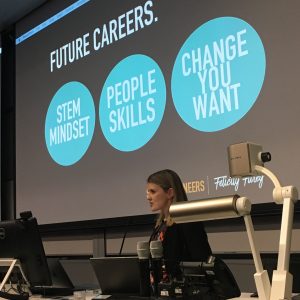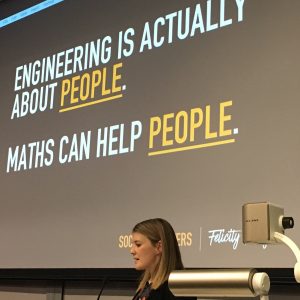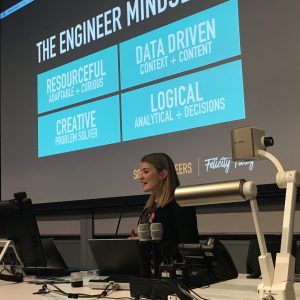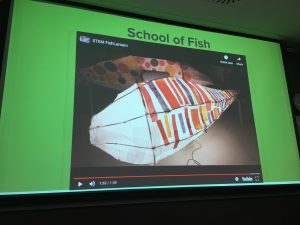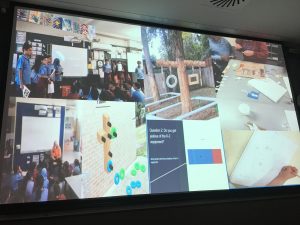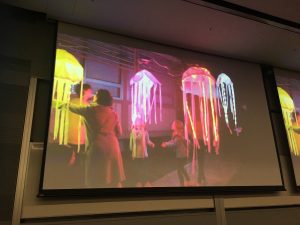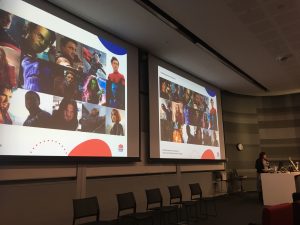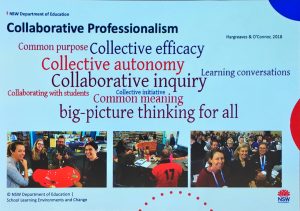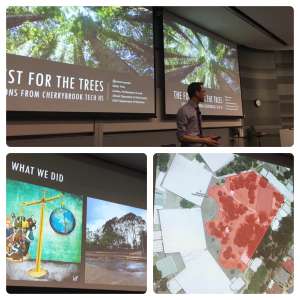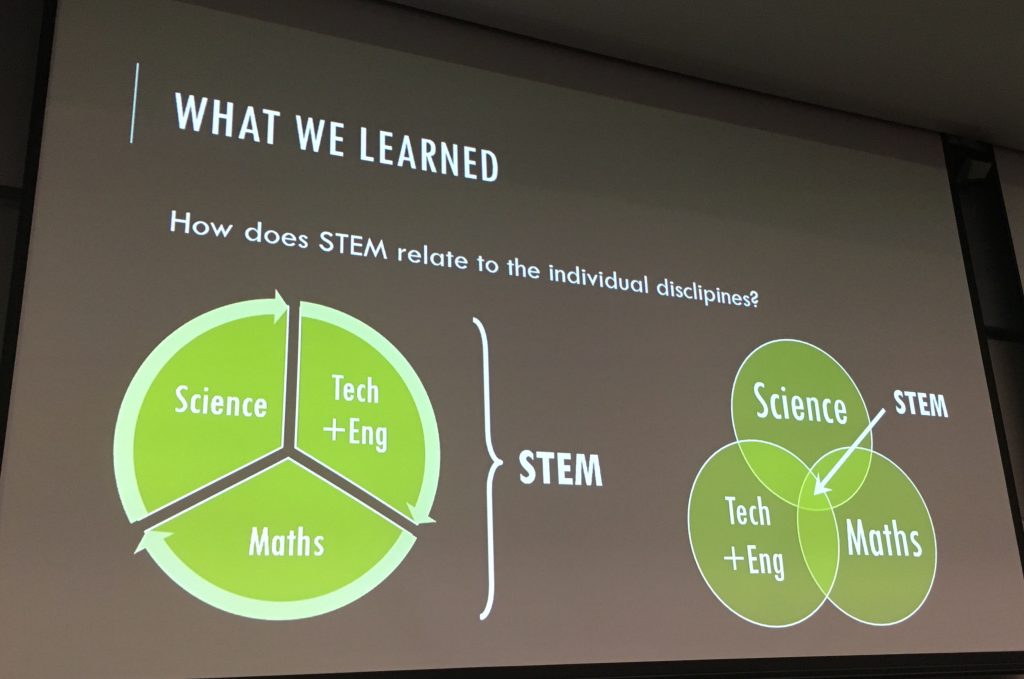On Saturday 10 August I attended the Sydney University STEM Teacher Enrichment Academy’s inaugural alumni conference, STEMMING the tide: Promoting STEM through Innovative Programs in Schools. What an amazing day of past and present academy schools presenting their STEM programs, pedagogical practices and student successes. With a mixture of keynotes, workshops and panel presentations there was so much to see and learn from each and every teacher, educator, and industry representative present. Here are a few of my reflections on the day.
Engineering is actually about people
The keynote speaker was Felicity Furey @Fecilitybriody (of machinam and power of engineering enterprises). Felicity made the connection between what people often think engineers do (the mathematics) and what they actually do (help people). She inspired us to think beyond the typical job of an engineer, highlighting that it’s not a sit-at-a-desk job but it’s more often about working with people, solving local problems, and managing projects. Felicity has a passion for engineering and helping young people (especially girls) in understanding what engineers do and the vast possibilities and jobs that engineering can lead to.
Felicity talked about focusing on the why, not just the how of engineering. This aligns to our focus in mathematics, where we want our students learning how to communicate and reason mathematically as they solve problems. Students need to see how STEM careers are about people-focused design, understanding the context of the bigger picture of what we are doing in stem beyond school-maths or other singular disciplines. Felicity listed four key elements of engineering that students need to engage in:
- Role models
- students investigating the perceived similarities across jobs and careers, they need exposure to different career pathways
- Collaboration
- participation in positive group work experiences
- Langauge
- students need to be spoken to with the language of inclusivity regarding what you ‘can’ be, not what you ‘can’t’ be
- Real-world element
- applying skills like area and perimeter from mathematics to a real-world problem like Will the town run out of water? or technology skills in using CAD for fashion designing
What a challenge to be left with, how do we bring these to the classroom? Some we already are, through inquiry-based learning, STEM as a pedagogical approach and through a focus on the 4Cs (communicating, collaborating, creativity and critical thinking). But there’s always room for more!
Authenticity: Why are we doing this?
We heard some short presentations from schools about their current or completed projects and STEM ways of working in each context. What came across from all these presentations was a strong focus on the authenticity that’s required. For a project to happen, and for the practices and processes to be sustainable, the students needed to be engaged in addressing or solving a local problem or issue.
Sydney Secondary College (Leichhardt) shared their cross curriculum project where year 8 students were designing their own curriculum. They also mentioned their future goal of partnering with their local feeder primary schools. Hebersham PS shared the way they use technology in the form of the See Saw app to give student voice to their STEM projects. The success has been in engaging high numbers of parents and family members in regularly interacting online to gain an understanding of the teaching and learning happening in the classrooms. John Edmonson High School’s projects were student-created and explored environmental areas such as self-watering plants and recycling. Wagga Wagga Christian College were embedding inquiry practices via the Reggio Emilia 100 languages of learning to engage students in STEM. Asquith Girls HS spoke of passionate teachers and a supportive executive as playing a large role in their success in creating entrepreneurs in STEM.
Schools presenting their successes and future directions in STEM. Many focusing on the communicating and sharing of students’ ideas and solutions to authentic problems. #usydstem @stemacademysyd pic.twitter.com/PvLRUEeP63
— katherin cartwright (@kath_cartwright) August 10, 2019
Successful STEM learning in schools need to be driven by school planning and backed up by funds and resources.
Alice Leung’s tweet from the conference
Key drivers for success of STEM
Great success story told by the research data from #USYDSTEM Academy @ICTENSW @ACCE_AU #ozcschat #ozcsteachers #JCUtech pic.twitter.com/4lxqKoC1cg
— Leanne Cameron (@LeanneCameron) August 10, 2019
Dr Deborah Tully reported on some of the current research that she is conducting with past STEM academy schools regarding sustainability and growth of their STEM projects. Among Debbie’s list of factors and influences, the key drivers in the success of these schools’ projects were: support from executive, expanding stem community – connecting to industry, real-world connections and time.
Ways of thinking, knowing, and doing
Julie King, Project Lead, Digital Technologies in focus and Curriculum Specialist, Technologies from ACARA (Australian Curriculum, Assessment and Reporting Authority) updated us on the current work that ACARA are doing in the STEM area. Julie talked about making authentic connections across learning areas, not just working from one learning area and only touching on another. As a mathematics educator, this was something I strongly agree with as mathematics is often the add-on in STEM when it sometimes needs to be the star. ACARA have illustrations of STEM connections and are currently developing STEM practices that focus on six STEM dimensions: relationships, patterns, structure and function, systems, measurement and data, and modelling and models. I am keen to see what these look like as these dimensions dovetail nicely with many of the Big Ideas in mathematics.
Practical examples of STEM in action
- Loreto Kirribilli
- STEM elective, increased from 10 to 37 students in 2 years, this year connecting with Taronga Zoo investigating bio-mimicry, students designing their own paths, no marks – focus on feedback
- St Augustine’s Primary School
- rural school, successful chicken coop project but mentioned this was hard to replicate so now focusing on making outcome connections to drive more open investigations ‘hatching ideas’, focus on ‘timely teaching’ of skills as needed, Starry night (Vincent Van Gogh) project
- Auburn West PS
- success with student collaboration and focusing on mathematics, connecting to industry (Social Venture Australia) and high focus on co-teaching, creating sustainability through up-skilling students and staff as go-to STEM helpers
- Burwood Girls HS
- Ilumin8 project (think Vivid but better!), successfully run for three years STEAM with strong Visual Arts focus, great use of recycled materials
- Orange Anglican Grammar
- securing success through deep learning, surface-deeper-transfer sequence in process of projects and teaching, designing a new library space, using Hattie and Donoghue‘s model of learning
Culture eats strategy for breakfast
Peter Drucker
Anyone who starts their presentation with a Marvel End Game metaphor is obviously going to be awesome and Kirstin didn’t disappoint. Kirstin Beck @Kirstin_Beck (substantively DP from Alstonville PS, currently NSW DoE’s School Learning Environments and Change Advisor) inspired us to become the superheros of STEM in our schools. Her main message was that STEM is a culture, not creation (of an end product or project or program). For STEM as an approach to be a success, it needs to become “this is just the way we do things here”. At Alstonville PS it’s been a long journey over at least the past 5 years to change students’ views and perceptions of what learning looks like.
Life isn’t in silos
Kirstin Beck
Kirstin emphasised that life isn’t in silos, so why should learning be. It’s not to say that each discipline within STEM doesn’t deserve its own focus, but that their connections need to be brought to the fore (a sentiment echoed by Eddie Woo in his presentation). At Alstonville they made time for what they valued, participated in teacher collaboration, and planned, wrote and evaluated units that suited their students. They shifted the lens from seeing what happens at school as ‘work’ to seeing it as ‘learning’. Students led their change and shared their learning journey through learning conventions, this increased student agency and created a culture of collective efficacy among the teachers. If you would like to hear more from their students, they have created a film pond movie Developing student agency through STEM learning.
The forest for the trees
Eddie Woo @misterwootube, from Cherrybrook Tech High School shared his school’s STEM journey to improve their school’s playground. He used the metaphor of redwood trees, some of the tallest trees in the world, that are only able to grow so high as they have an intricate interwoven roots system, and that’s what was needed at Cherrybrook. With approximately 2000 students (in a school built for 800) making connections between students and across disciplines was essential.
The lessons they learned as a whole team was: people, people, people. Just like in real estate where it’s location, in STEM for them, it was the people selected. Teachers needed to work together, be flexible with timetabling and sequencing of content in their programs. They failed early, when trying out what Eddie referred to as “glorified task projects” that were more like one-off lessons. Although they as teachers thought they would be engaging, the students didn’t. What mattered to the students were, not surprisingly, themselves (and their immediate environment). There was a part of their playground, a thoroughfare, that was either a dust bowl or a mud bowl. This problem was engaging to the students as it came from them. Eddie said the biggest power of STEM was turning questioning on its head and letting the students ask the questions which in turn drove their desire to learn.
As I mentioned when talking about Kirstin’s presentation, Eddie made it clear that at school and even within a STEM approach, individual discipline teaching and learning still have their place. There are times when we need to front-load students with some of the skills and other times where they are more in-the-moment teaching opportunities that come from the students’ questioning and wondering.
Numeracy is the application of mathematics, this fits well within STEM, however, there are conceptual understandings within mathematics as a discipline itself that require their own time. This is true for all disciplines within STEM. Transdisciplinary approaches blur the boundaries of discipline and allow for the construction of meaning in the context of real world problems, but that doesn’t mean it does or should be our only approach to teaching and learning.
Your school can find out more about the STEM Teacher Enrichment Academy at Sydney university through their website. They are currently looking for schools interested in participating in the next round of projects. You can also check out #usydstem on Twitter for more reflections from other attendees at the conference.
